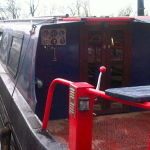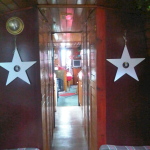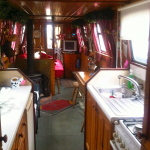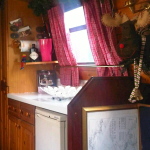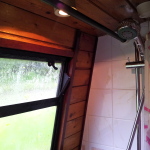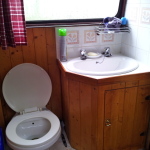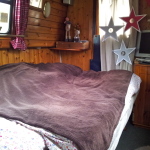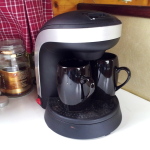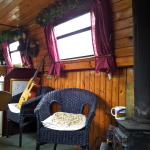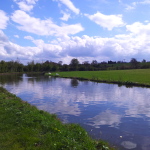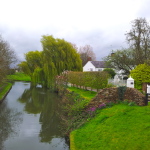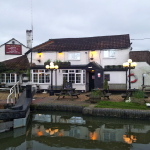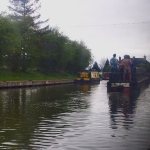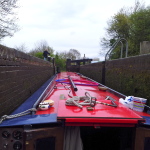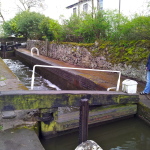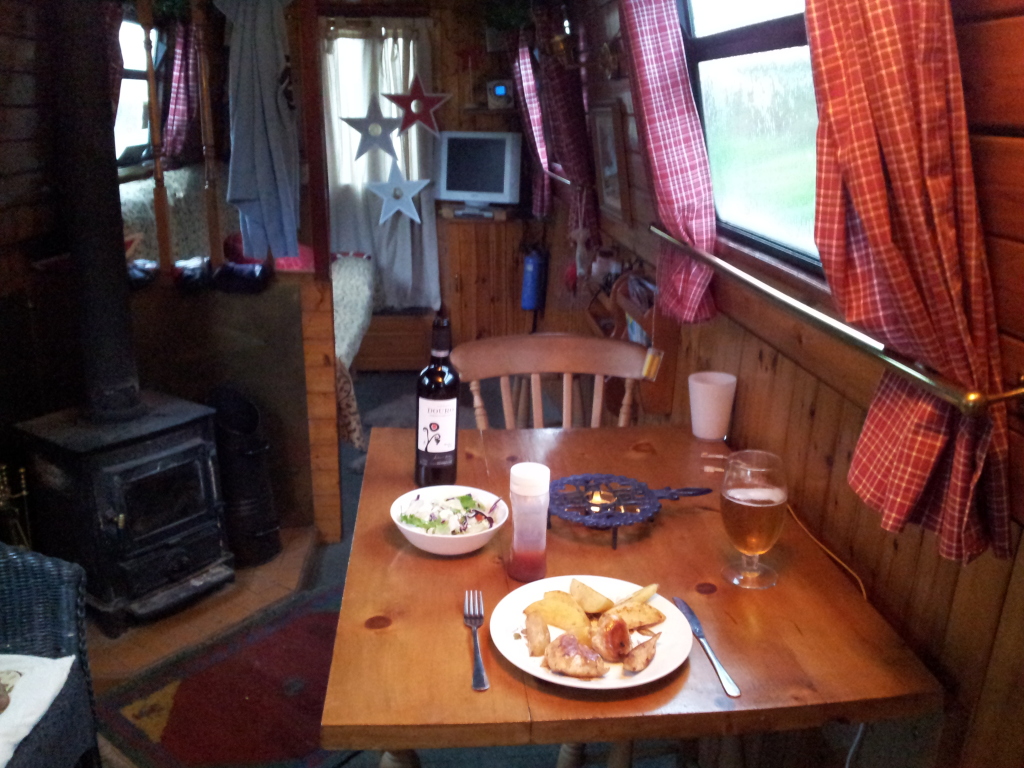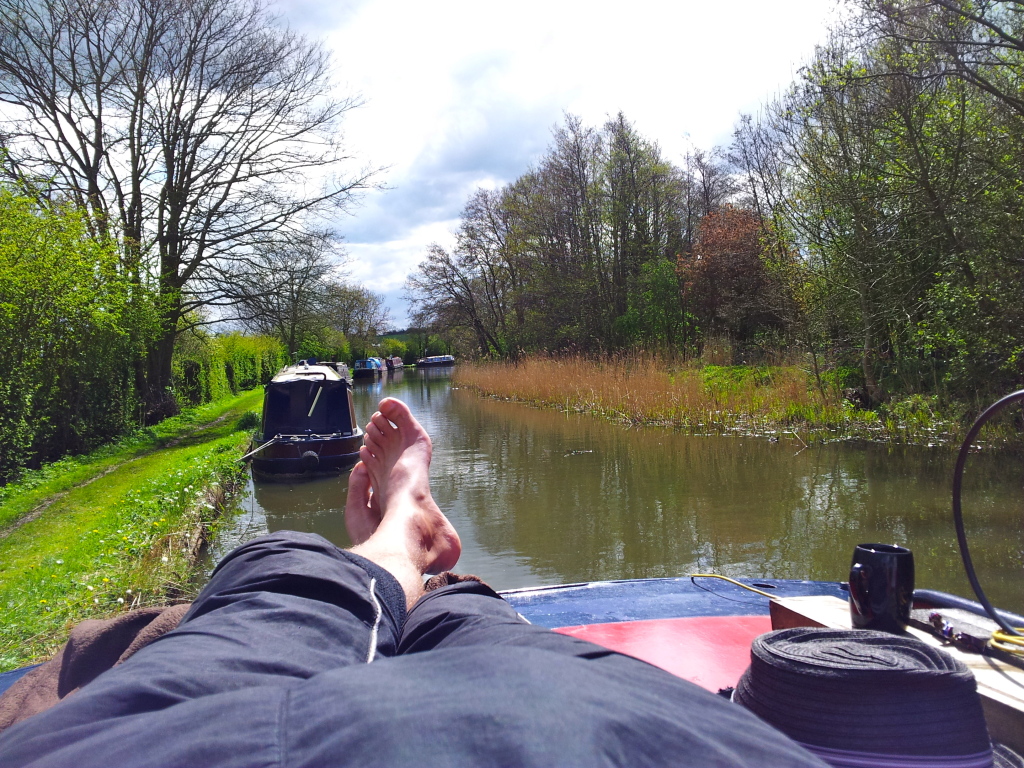Emma is a lady in her best years, sensitive but also tough – she is leaving England for France, to make sausages for English expats. Strange, don’t the French have the best sausages? – anyway. She was living on a narrowboat the last few months. And now she is renting her narrowboat to us – no not us, me.
Right before our boat journey started, Mel kicked me out of the house, and I deserved it. But what shall I do? I don’t know many people in London, so the best option seems to live in the boat anyway. And I have a feeling our story is not over …
Emma picks me up in Solihull station and brings me right to the Earlswood Club, where the boat is moored. We sign the contracts and then she is going with me on tour. For 3 days she wants to show me everything on board, and how to steer the big pot of 52ft.
I am very curious about the boat – is it as nice as the photos? Yes, it is. It is a little jewel, and I will ride it to London!
- Sun reflections on the roof
- Cosy kitchen
- Shower
A BRIEF HISTORY OF BRITISH WATERWAYS
The journey is very interesting. The first 4 days we follow the old coal route from Birmingham to the grand union canal, and from there to Braunston. The British canal system of water transport was the first nationwide canal network. It played a vital role in the UK’s Industrial Revolution which began during the mid-18th century. The period between the 1770s and the 1830s is often referred to as the “Golden Age” of British canals. During this time, the canal system rapidly expanded to nearly 4,000 miles (over 6,400 kilometres) in length.
From 1840 the new built railways were taking most of the transportation business, and slowly taking over the canal corporations. The decline in water-transportation had an effect on the boatmen who faced a drop in wages. As a result, they had to take their families with them. Life was hard, the space on board was very limited, and children couldn’t go to school. I like that “ordinary” people called them “water-gypsies” – even though boatsmen didn’t like this term at all.
The boats on the canal were first horse-drawn with a towpath alongside the canal for the horse to walk along. In the early 20th century, steam and diesel progressively replaced the horses.
After the second world war, the transportation of goods on the canals stopped completely. Since then, the canals are used for leisure purposes only. Today, more then 30.000 boats are licensed with Canal & River Trust (formerly British Waterways).
But back to the boat.
The weather is bad, cold and rainy. The landscape is amazing – green, greener, greenest. Cows and sheeps, cottages.
I am shocked how small the canals are, and how many locks we have to do.
Emma is letting me the tiller and opening and closing most of the locks on our way. She is working like a horse. Sometimes there are several locks right after each other, bringing the boat to another level, up or down. It takes you ages to fill the lock, open it, drive in, empty the lock, open the gates, drive out and close the lock again. It’s essential to have a partner on this first part of the journey. The second person can open and close the gates and operate the locks, while you are just driving in and out. Still it takes time. For a record-series of 13 locks in a row and around 500m distance we spent half of the day …
Emma is not holding back with critics about my driving. “You are too fast”, she is saying every time I bump a little bit too fast into the concrete. Yes, I like to pull the gas, and then go laud into reverse to stop the speed of the boat.
Only weeks later I discover that this journey is not about speed. We are driving with walking speed, 3-4 mph. If you accelerate more, you can go with a maximum of 6-7, but then you make a braking wave that destroys the banks and endangers the environment of wild animals, like birds. Narrowboating feels more like riding a Harley than a Ducati.
In Braunston, right before the long long Blisworth tunnel, Emma is leaving me. She has shown me enough: how to steer a 52 ft narrowboat, driving through a lock with another boat attached on your side, how to refill diesel and water, pump out a toilet, shower on 0,5 m2, using a staircase lock to lift your boat 10m, pull up and down a drawbridge, drive through 5 locks in a row, steer through a small tunnel with two way traffic, open a CRT toilet with the universal key, moor on a countryside bank, and make beans on bread.
Emma and me shake hands and then the key to this swimming giant is in my hands. I celebrate the first evening alone on the boat with Spanish music, Portugese red wine and British chicken and chips.
BLISWORTH TUNNEL
Now it’s on me to drive through England’s longest canal-tunnel for diesel-engines (3075 yd).
The journey takes about 30 minutes, everything in absolute darkness. The only light comes from my front lamps 50 feet ahead and is showing me the bow of the boat and parts of the tunnel walls left and right. The rest of the boat and even where I stand, is in complete darkness. The diesel engine is very loud. I listen to every change in tone. When your engine breaks in the middle of the tunnel, like it happened to my friend Benois, you have to paddle a multi-ton boat for more then a kilometer in absolute darkness …
The more I come to the middle, the more I get dizzy from the clouds of diesel that fill the non ventilated, narrow tunnel. From time to time, a fountain of water comes from the top of the ceiling, like a mini waterfall. After about 2 kilometres, another boat approaches me. I see the lights of their lamps and take off the speed – the tunnel is exactly 2 narrowboats wide. I need to be very concentrated not to hit the wall or the other boat. Finally we pass each other in slow motion, the captains silently greeting each other. After a long time, the end of the tunnel comes in sight, first as a small dot of light, then it becomes gradually bigger and bigger. More and more light fills the space, and finally the bow brakes through into the day. It’s raining on the other side, but I am really happy that I have made it through.
Nevertheless, it’s not always raining – yesterday the weather was sunny and nice for the first time, and the canal was leading me through a beautiful part of England. Fields of yellow blossoms, green trees, farms, cows, sheeps .. I felt like driving through a paradise. In the early afternoon I stopped in a curve, facing reed grass and wild trees, some ponies behind me. I hammered two pins in the ground, fixed the boat on ropes and made a short happiness-dance.

